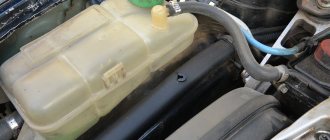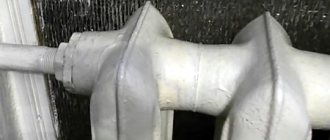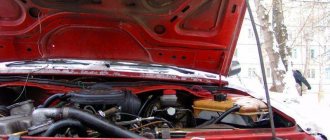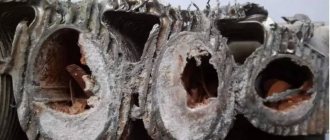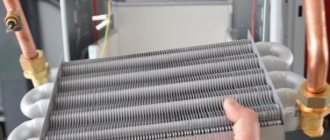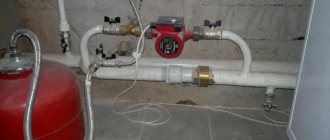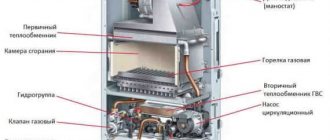Flushing the engine cooling system is a mandatory procedure for every motorist. The scale, dirt, and rust remaining inside ultimately clog the radiator channels, pump, and pipes.
To prevent this, it is important to determine the moment when the structure needs cleaning and choose the appropriate product. To remove deposits, both traditional and special cleaners are used.
In this article we will tell you how to flush the engine cooling system from rust and scale at home.
When is flushing necessary?
Internal cleaning is recommended at least once a year. It is best to do this after winter is over. A light indicator with a picture of a radiator helps determine the exact time. In addition, there are other signs by which one can judge the need for cleansing.
These include:
Systematic engine overheating and failures when starting it.- Inertia of the rheostat, inhibited response to its signal.
- High temperature readings from the coolant sensor.
- Interruptions in the operation of the pump, signaling problems in the system.
- Change in the color and smell of the refrigerant in the expansion tank.
Centralized cleaning or individual
Residents of apartment buildings can clean the heating system individually and centrally. Utilities provide such services using primarily hydropneumatic technology. But for this, the procedure must be agreed upon with the neighbors, and certain material costs will also be required. Centralized flushing may take some time. For owners of private houses, only individual cleaning is possible.
What do you need to know before the procedure?
Flushing the cooling system is a serious procedure that requires car maintenance skills. Improper cleaning can lead to problems, so before starting the procedure you need to familiarize yourself not only with the structure of the mechanism, but also with the cleaning rules.
The cooling system includes parts made from different materials. They differ in different resistance to chemical reagents. Ignoring this fact can lead to corrosion of some components and cause even more serious consequences.
For example, if the air conditioner condenser is made of aluminum, then the use of citric acid may cause thinning of its walls . At the same time, cast iron and steel parts completely retain their integrity.
The design of the cooling system should also be taken into account. Thin channels can be damaged if, during cleaning, fragments of a thick film of old antifreeze, pieces of rust or scale come off. If the channel is clogged, the engine will overheat.
To avoid problems that arise during radical cleaning, it is recommended to carry out prevention, use the original antifreeze composition and change it on time.
Battery cleaning brushes and sponges
To remove old stains, the following will help:
- A toothbrush, brush or narrow paint brush with stiff bristles. They are able to crawl into the most remote corners of the radiator.
- Sponge. If you attach it to a long ruler, it can also clean hard-to-reach places.
- Rubber glove. You need to put it on your hand and wash it well with laundry soap. Then rub off stubborn stains on the heater using your fingers. Can be replaced with old cut-off tights or socks.
- Dishwashing brush. Use this brush to clean the battery. They are sold in hardware stores and have a comfortable long handle.
- Spray. In order to wash the inside of old batteries, you need to add detergent to the spray bottle and spray the dirt. Wait a while and wipe the soaked areas with a damp cloth.
Before using cleaning chemicals, you should carefully read the composition. Since it may contain aggressive active substances that can easily destroy the surface of the radiator.
Products for home use
With proper care and preventive maintenance, cleaning the cooling system is not difficult. Before starting the procedure, you need to prepare it:
The engine is cooled if it was running before.- Place a container for old antifreeze under the drain.
- Unscrew the plugs from the bottom of the radiator and cylinders.
- Wait until the liquid is completely drained from the system.
- The drain plugs are screwed back in.
- Fill the expansion tank with cleaner.
Distilled water
If over the past years the car has been kept in order and preventive washes have been carried out, then the use of distilled water is considered sufficient.
It is poured into an empty expansion tank . The amount of distillate must correspond to the volume of the container. After this, start the engine for 10-25 minutes.
For best results, it is recommended to take a test ride. After turning off the car, allow time for cooling and drain the water from the tank.
If the poured distillate contains flakes or rusty sediment, then repeat the cleaning. When the poured water shows that there are no impurities, fresh coolant is added.
Lemon acid
This product helps to cope with a small degree of contamination. To prepare the working solution, citric acid is dissolved in water .
The standard proportion is 30-40 g per 1 liter. To enhance the effect, prepare a more concentrated solution, increasing the dose of powder to 80-100 g. The optimal pH value of the lemon reagent is 3.
After the cleaner is poured into the tank, turn on the engine and warm it up for 15-25 minutes. Leave the reagent in the system for 5-12 hours. When draining the solution, visually check the degree of contamination . If necessary, the cleaning procedure is duplicated.
You can learn more about the use of citric acid in the fight against rust here.
The video will show you how to flush the cooling system with citric acid:
Vinegar
For washing, use vinegar with a concentration of 9% . For 5 liters of water you need a glass of acid (250 ml). This cleaner is used by analogy with citric acid.
The acetic reagent is poured into a container from which the antifreeze has previously been drained. Fill the tank with the prepared solution, start the engine for 20-30 minutes. The acetic liquid is drained after 8-12 hours. Flush the system with distillate and fill it with new refrigerant.
You can learn more about the use of vinegar in the fight against rust in this article.
Milk serum
For work, use store-bought or homemade serum . In the latter case, the liquid must be filtered through several layers of gauze so that no curdled inclusions remain in it. The serum should not be diluted with water before use.
Pour liquid into the system, start the engine for 30-40 minutes and do a test run, preferably without stopping. To remove traces of the serum after it has been drained, the tank is filled with distilled water and the car is started again.
Soda
The washing solution is prepared from soda ash (8-10%) and caustic (3%) soda.
The powder is diluted with water, its amount in the solution should be 85-90% . After filling the tank with soda reagent, the car is driven 50-100 km. Then the cleaner is drained and the distillate is passed through several times.
The soda solution should not be left in the cooling system for a long time. The maximum time is a day.
Cola
The drink contains orthophosphoric acid, which dissolves salt and rust deposits. However, the method is considered not the safest, since acid has a negative effect on rubber pipes, and sugar has a negative effect on metal surfaces.
If the choice is still made on this purifier, then carbon dioxide is first removed from the drink. After filling, the engine is left in working condition for a maximum of 15-20 minutes. After removing the Coca-Cola, the system is cleaned with distilled water. Read more about using Coca-Cola against rust here.
Special formulations
Ready-made chemical cleaners are divided into four groups:
- neutral,
- acidic,
- alkaline,
- combined.
To select a suitable liquid, it is necessary to determine the degree of contamination of the cooling structure and the type of deposits.
For preventive treatment, neutral compounds are purchased. Acid products are suitable for removing inorganic impurities. Organics are removed using alkalis. Two-component ones are used as universal remedies for all types of pollution.
Our range of effective chemical washes includes:
- LAVR. Russian-made foam decarbonizer is intended for trucks and passenger cars. For rinsing purposes, first fill in liquid from bottle No. 1 and water. Start the engine for a quarter of an hour. Drain the first reagent and fill in liquid from bottle No. 2, adding water. Leave the car again with the engine running for 15-20 minutes. Flush the system with distillate two or three times. A set consisting of two bottles costs an average of 500 rubles.
Hi-Gear Radiator Flush .
Product manufactured in the USA. Suitable for passenger cars. There are no acids in the formula, so the cleaner is safe for rubber elements. The product is poured into the tank with a cold engine, after mixing the entire volume of the bottle with 4-5 liters of water. Start the engine for 7 minutes at a speed of 1500–2500 rpm.Then wait until the engine cools down, drain the chemical and wash it with distillate. The average price of a bottle is 350 rubles.
- LIQUI MOLY Kuhler-Reiniger . A German remedy classified as neutral. Ideal for cleaning rust, oils, emulsions. The reagent is added to the coolant at the rate of 300 ml per 10 liters of refrigerant. Start the car and keep it idling for up to half an hour. After switching off, if necessary, leave for another 3 hours. Then the contents are drained and washed with distillate. A bottle sells for an average of 460 rubles.
How to flush a car heater radiator
Flushing the stove radiator video
The stove radiator can be washed either with or without removing it. In the latter case, usually cleaning compounds are simply poured into the radiator or driven by an additional pump connected to the pipes, and then washed with water.
Flushing the heater radiator without removing it
It’s easier to rinse the heater radiator without removing it. To do this, use one of three methods - using two plastic bottles, using a suspended large plastic bottle, or using an external water pump. The described methods allow you to create pressure in the radiator, under which cleaning liquid will circulate inside it.
Washing plastic bottles
Flushing the stove radiator using two plastic bottles
The method of washing with plastic bottles allows you to wash the radiator of the stove in two ways - in a removed state and directly in place from the engine compartment. To operate, you need the following tools: two one and a half liter plastic bottles, radiator cleaner, four clamps. The essence of the method is that the flushing liquid is poured halfway into the radiator and one bottle, alternately driven from one bottle to another by pressing on the bottles with hands or feet. In this way, its internal cavity is cleaned. The method is very simple and effective. When the liquid is very dirty, it needs to be replaced with clean one.
Another method is to cut off the bottom of a large plastic bottle (five to six liters), thus creating a watering can from it. And hang it higher, thus creating pressure for the liquid flowing out of it. Connect one hose to the neck and the first radiator pipe, and the second hose to the other radiator pipe and into a bucket on the floor. To ensure a tight seal, it is advisable to secure the hose to the radiator pipes using clamps.
When flowing out from a height, cleaning fluid under pressure will clean the internal cavity of the radiator. Continue working until the new fluid is sufficiently clean.
Flushing the radiator using a car pump
One of the most effective methods is to make a device based on an external liquid pump, which ensures constant circulation of detergent inside the stove radiator under pressure.
Flushing the heater radiator using a car pump. Photo taken from drive2.ru/users/ya-rusich
To make the device you will need: an electrically driven car pump, three hoses that match the diameter of the radiator and pump leads, a battery charger, an immersion boiler (which needs to heat the liquid), a solution container, a filter element (a synthetic sock or stocking), cleaning composition, a stand for a container with a solution at the pump level.
Connect the pump (inlet/outlet), the radiator (inlet/outlet pipes) and the basin containing the warm cleaning solution with hoses. Place a sock filter on the end of the outlet hose. Start the pump from the battery terminals so that it “drives” the liquid in a circle. And don't forget to connect the charger to the battery as it puts a lot of stress on it.
This will create a looped system through which the cleaner will circulate through the radiator. It is recommended to “drive” the liquid for an hour in one direction and an hour in the other direction. Then replace the fluid with clean one and repeat the procedure again. When finished, rinse the radiator with boiled or distilled water for half an hour in each direction.
All the described methods can also be used if the stove radiator is removed from its seat. This will allow you not only to clean it under pressure, but also simply by pouring special cleaning agents into it. In addition, an additional advantage of dismantling is that the car owner will have the opportunity to remove debris and also inspect it for damage and corrosion.
Recommendations
When cleaning the cooling system, it is recommended to follow the instructions included with the selected cleaner. It is also useful to remember some important points:
- after cleaning, the system is thoroughly washed with distilled water;
- if there is heavy contamination with rust and scale, the cleaning should be repeated;
- if the cleaner is poured into a still warm system, then it should also be warm;
- When choosing a chemical reagent, the scope of its application should be taken into account.
The cooling system must not be filled with household chemicals intended for removing scale and grease from plumbing fixtures and dishes.
All the most useful and important information about the methods and methods of removing rust from a car is here.
Causes of blockages
The reason for this unpleasant situation is the low quality of the coolant of the central heating system, which contains various types of impurities and debris. There are also features of deposits depending on the material used to make the device. Cast iron batteries have a rough inner surface and are susceptible to scale and rust. Radiators made of aluminum and bimetal are prone to the formation of limescale due to the calcium, magnesium and sodium content in the water.
Basic methods
There are many ways to remove dust from a battery. You do not need to purchase any special tools; most devices are publicly available. Cleaning can be done using electrical appliances, improvised means, with or without the use of chemicals.
Electrical appliances
Thorough cleaning of the battery can be done using electrical appliances. It is important to take precautions.
Vacuum cleaner
You can use a vacuum cleaner for cleaning. It is advisable to use a narrow nozzle, this will allow you to penetrate hard-to-reach places. First you need to remove all dust and debris from the inside, then treat the outside. When finished, you can wipe the radiator with a damp cloth.
Hairdryer
To use a hair dryer, you must first place a towel or any thick cloth soaked in water under the radiator. Direct a stream of hot air onto the radiator. The dust will move from the battery to the damp cloth. Not the most effective way: dirt can remain between the sections, get into the air or walls, floor.
Steam generator
A steam generator will do an excellent job of removing contamination (especially accordion-type radiators). To clean, you will need to direct a stream of hot steam to the radiator. Such heat treatment will not only effectively remove even old dirt, but will also disinfect the surface. Under pressure, steam penetrates into narrow, hard-to-reach parts. To protect surrounding surfaces from exposure to steam, you can cover them with cloth or oilcloth. It is also important to know that the high temperature of the steam can negatively affect the coating: damage the paint.
Washing vacuum cleaner
A good alternative to a regular vacuum cleaner. It will cope perfectly even with serious dirt. Cleaning should begin from the inside, and then proceed to the outer surface. A washing vacuum cleaner, thanks to an aqua filter, can prevent the spread of dust throughout the room.
Available means
You can thoroughly clean the inside of the battery from dust using improvised means that are found in every home. The most popular means are presented below.

